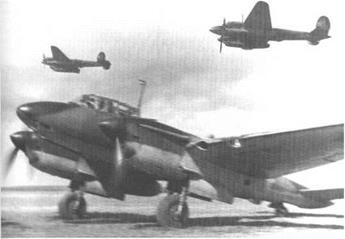General Winter
|
T |
he Russian winter arrived in mid-November, making the soggy roads freeze and become passable again. On November 15 the badly crippled Army Group Center resumed Operation Typhoon. With Moscow nearly in sight, the German commanders nurtured a hope to seize the Soviet capital with the last remaining offensive capacity of their air and ground forces.
Improved road conditions in the southern sector enabled Generalfeldmarschall Gerd von Rundstedt’s Army Group South to renew its attack against Rostov, the gateway to the oil fields in the Caucasus, on November 17. The Soviet Southern Front responded by launching a powerful counterattack from the northeast. The airmen of VVS-Southern Front supported the offensive with nearly four hundred sorties on the first day alone. This threat could be sealed off mainly through the vigorous action by StG 77 and the He Ills of KG 27 that were rushed in from Fliegerkorps IV. Despite a 500-foot ceiling and snowfalls, the few remaining Ju 87s in StG 77 were in incessant action, blowing up any Soviet attempt to resist. On November 20 the exhausted German troops reached Rostov. The next day the city’ was in German hands.
With the capture of Rostov, Army Group South had exhausted its last strength. On the Soviet side, fresh reinforcements were brought in to the north and east of Rostov.
Farther to the north, the drive to the east by the German Sixth and Seventeenth armies was bogged down at Severniy Donets, southeast of the city of Kursk. A parallel situation developed along the entire Eastern Front. The physically and psychologically weakened German
Volume I: Operation Barbarossa, 1941
troops had lost the energy and the material requirements to withstand the upcoming wave of renewed Soviet counterattacks.
As a symbolic finale to the German victory march on the Eastern Front, the Luftwaffe’s number-one ace, Oberst Werner Molders, left Chaplinka Airdrome on the southern combat zone aboard an He 111 from KG 27 early in the morning of November 22. Molders had been ordered to Germany to take part in the funeral of the late chief of supply and procurement of the Luftwaffe, Ernst Udet, who had committed suicide five days earlier. But Molders never reached his destination. The aircraft crashed near Breslau.
In the German underground resistance movement, a witness account was circulated -that gave a version different from the official story: A body had been seen falling from the He 111 in which Molders traveled. It is highly unlikely that this version is correct, but what is
true, although it has escaped widespread publicity, is that Molders turned against the Nazi government shortly before his death. The violations against men and women of the Catholic Church who spoke up against the atrocities in Germany had upset the Catholic Werner Molders. Having heard about the arrest of the Bishop of Munster, who had criticized the Nazis, Molders wrapped up all his decorations and his Nazi party membership card and sent the package to Nazi Party headquarters together with a protest letter in which he explained that he henceforth refused “to carry the insignias of this heinous regime.” In October 1941 Molders left his office in Berlin and traveled to the Eastern Front, where he found refuge among his fellow fighter pilots at Chaplinka. Some photos of Molders during these days clearly confirm that he wore no decorations or Nazi symbols whatsoever.

During the last days of his life, Molders turned his back on events in Germany and even on his appoint-
|
ment as inspector of the Luftwaffe Fighter Arm; he just happily flew some unauthorized combat sorties with ordinary front-line fighter pilots. He even scored a number of “unofficial” victories to be added to his official score of 115.
The loss of the incredibly popular “Vati” Molders struck the German airmen on the Eastern Front, especially the fighter pilots, as a bad omen.
In late November 1941 the Wehrmacht on the Eastern Front was a mere shadow of what it had been five months previously. Losses had brought down the strength of army and Luftwaffe units to 30 or 40 percent, or even less, of their original strength. The veteran front-line soldiers were marked with strong battle fatigue after five months of intense, incessant combat. Another major problem was the overextended supply lines, where columns
traveling hundreds of miles on primitive roads ran the constant hazard of partisan ambushes. At this point the Germans faced the stiffest Soviet resistance so far encountered.
The temperature drop—at first welcomed by the Germans—continued. During the afternoon of November 27, the temperature fell to 40 degrees Celsius below the freezing point. “General Winter” struck the final blow against the strength of long since battle-weary German soldiers and airmen.
Luftwaffe operations were severely hampered by stiffening engine oil in the cold on the primitive front-line airfields. Having stood parked outside in minus- 40-dcgrce-Celsius w’eather all night, the engines of many Messerschmitts, Junkers, and Heinkels simply refused to start on many a gray winter morning. The Red Air Force came off far better on their well-equipped airfields. The











